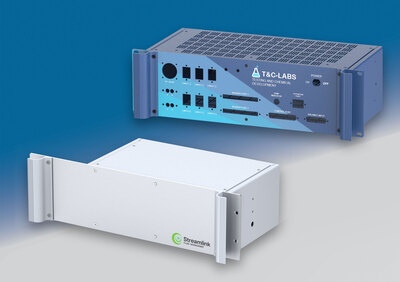Custom solutions for complex rack installations

There is an increasing interest in shallow-depth and offset/asymmetrical cases for 19″ rack electronics. They’re becoming more popular for a wide range of applications — fitting neatly into spaces where deeper or conventional symmetrical enclosures would be impractical or impossible to use.
These cases are suitable for wall-mounted racks, where space constraints and weight considerations call for a compact and lightweight solution. These features make them perfect for applications in health care, retail or edge computing where space can be limited.
Shallow 19″ rack cases offer space-saving installation and optimised airflow
Shallow-depth rack cases are smaller and weigh less, so they’re significantly easier to handle and install — an essential feature for applications where space inside the rack is at a premium.
Devices designed to operate in shallow-depth rack cases typically generate less heat compared with larger, more power-intensive equipment. This makes cooling less complex and more efficient.
Applications for shallow 19″ rack cases
Shallow-depth case applications in automation typically include programmable logic controllers (PLCs), motor controllers and remote input/output (I/O) modules for data acquisition and control. For networking and communications, the cases are specified for switches, IoT/IIoT gateways and fibre-optic distribution units.
In test and measurement, shallow cases can be used to house data logging, signal generation or spectrum analysis devices. These cases are also specified for A/V and broadcasting applications such as digital signal processors, video switchers, stage lighting/digital multiplex (DMX) controllers, portable recording equipment and rack-mounted computers for editing and playback.
Shallow cases are also used to house medical imaging equipment (ultrasound or portable X-ray machines) and diagnostics instrumentation in laboratories or mobile healthcare units. They also find favour with the military for radar control units and communications relay systems in field deployments.
They’re often used in outside broadcast vans that require a compact yet robust housing for video switchers, recording equipment or communications systems. Meanwhile, the retail sector specifies shallow cases for point of sale and for driving digital signage displays.
Offset/asymmetrical 19″ rack cases for complex rack configurations
Offset cases help electronics designers to squeeze more space out of racks when a functional, spatial or ergonomic requirement makes a symmetrical design impractical. These configurations provide flexibility for installations where standard layouts cannot accommodate the specific equipment or cabling needs.
Some components (power supplies or fan modules) may be deeper than others (network switches or patch panels). An offset design allows one side of the rack to house deeper components while keeping the other side shallower to save space.
These cases are also a great choice when there’s a need for increased space on one side of the rack for routing and organising cables. In networking applications, one side may house shallow devices such as patch panels, while the other side accommodates cable bundles or cable-management trays.
Asymmetrical designs can also be used to optimise weight distribution, particularly for portable or mobile applications. Heavier components such as amplifiers or power supplies can be positioned closer to the centre of the rack for stability, while lighter equipment occupies the offset portion.
In test/measurement or military applications, equipment can often be modular or non-standard in size. Asymmetrical cases allow for bespoke configurations, such as housing a control interface or display on the shallow side while reserving the deeper side for processing units or power systems.
For thermal management, offset cases can direct airflow across specific components with higher cooling demands while leaving other sections vented or sealed as needed. This is common in telecommunications or industrial automation where some components generate more heat than others.
Offset cases are sometimes chosen to enhance accessibility or aesthetics. For example, front-facing displays or controls might be positioned in the shallow section, while deeper components are hidden or mounted further back for a clean and ergonomic layout.
Which 19″ rack cases are suitable for shallow and offset designs?
METCASE offers four 19″ rack cases: COMBIMET, VERSAMET, UNIMET and METTEC — all of which can be supplied in shallow depths on request. For offset designs, COMBIMET is the recommended housing.
Further customising options
In addition to custom depths and offset designs, modification options for METCASE 19″ rack cases also include:
- Custom front panels
- CNC machining — punching, folding, milling, drilling and tapping
- Fixings and inserts
- Custom colours (powder coating, wet painting)
- Photo-quality digital printing of legends, logos and graphics.
All customisation work is carried out in-house to save time, money and administration. It’s also better for the environment because the enclosures don’t have to be shipped between multiple suppliers.
Contact
Metcase offers advice on the best standard or customised enclosures for a range of rack-mounted electronics.
Transforming acoustic waves with a chip
Researchers have developed a chip that uses on-chip phased interdigital metamaterials to shape...
Mechanical strain boosts lead-free ferroelectrics
Scientists have discovered a way to boost the performance of lead-free ferroelectrics using pure...
Crypto chip keeps water flowing in rural communities
Twisthink has integrated Microchip's ATECC608B crypto chip into an IoT pump sensor, to...





